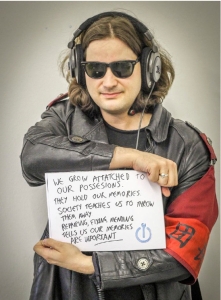Client: The Restart Project
- What do Making and Repair activities actually achieve, in social and community terms?
- Can fixing material things have a social impact, or achieve other kinds of transformation?
The Restart Project is a social enterprise which catalyses, encourages and organises workshops across London where people can come together to repair and re-use various things from their homes. The project encourages sustainability and re-use, especially of domestic electronic goods, so as to develop a more sustainable use of domestic resources and goods.
“Fixing to me means a new life for old things” (Gaz)
(Photograph by: Heather Agyepong)
What The Restart Project was interested in exploring with the Material Life Studio was the community dimension of the workshops, and to think about the social side of the events themselves. On the one hand, The Restart Project achieves its aims through mobilising community networks – in most localities, there is a wealth and breadth of local repair skills and expertise, and a lot can be achieved if only one is able to bring these together. An expert in computer repair can be put in touch with someone who knows about kitchen weighing scales. So the community is a resource. On the other hand, sometimes the workshops might be about the opposite: perhaps what is important to people is not repairing their things, or even achieving a more sustainable lifestyle, but using the repairing as a kind of crafting activity to bring the community together. So the community is not just a resource, but is being built and strengthened somehow.

What range of parallel Transformations might ReStart achieve: of individual people, of objects, and of collectivities?
A team of three members of the studio (Maki Ogawa, Maria Lopez Belatti, and Kunfang Zhao, postgraduates at UCL with experience in anthropology, industrial design, furniture design, and fashion marketing) attended several workshops, talked with participants and gained a sense of what was going on. After a period of reflection on what kinds of themes emerged, and talking with Janet Gunter of The Restart Project, the group returned to workshops and gathered more specific kinds of information.
- What kinds of difference does fixing make?
- What kinds of social relationship are established and developed during events?
- What happens after the event? – do social connections and relations continue?
- How do the actual, material things being repaired, and what physically happens to transform them, matter within the workshops? How do these objects have meaning?
“Fixing is intuition, investigation, inspiration” (Matthew)
(Photograph by: Heather Agyepong)
The work group provided The Restart Project with a number of user journeys and accounts of participants. We analysed the events in terms of five different kinds of relationship which we observed developing around objects-under-repair, so as to try to provide a kind of mapping of what was going on which the organisers might use. We then developed some possible publicity materials, using still images and video, to bring across the message of The Restart Project to a wider audience and make something happen in a wider way.

“We grow attached to our possessions. They hold our memories. Society teaches us to throw them away. Repairing, fixing, mending tells us our memories are important” (Joseph)
(Photograph by: Heather Agyepong)
Heather Agyepong’s photographs from the work may be viewed on The Restart Project’s Flickr Page:
……………..
Project Work By: Maki Ogawa, Maria Lopez Belatti, Kunfang Zhao
Contact at The Restart Project: Janet Gunter
Work conducted: Summer 2014

